The 5 Best Camping Stoves of 2024
This post may contain affiliate links.
A camping stove is the cornerstone of your outdoor kitchen. In this guide, we drawn on our years of experience developing camping recipes for a living to help you cut through the noise and find the best camp stove for your next outdoor adventure!
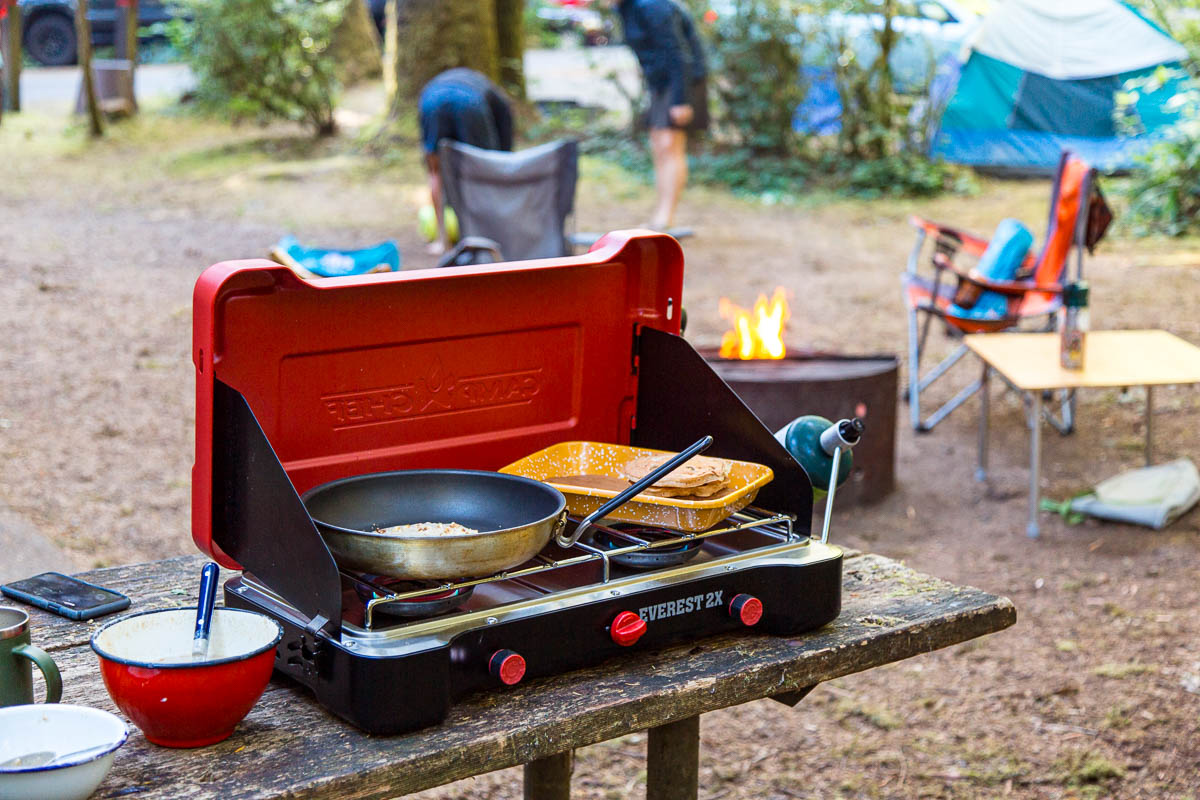
One of the most important items on your camping checklist is a good camping stove. It should be reliable, easy to use, and a pleasure to cook with.
But figuring out which camping stove model is right for you can be overwhelming. There are just so many different options! Various fuel types, new features, and—of course—a wide spread in price points.
The good news is we’ve done much of the hard work for you! We’ve whittled the list down to just the very best camping stoves on the market and we’ll walk you through the most important features to consider. We also give you our top recommendations.
While there are tons of different types of camping stoves to choose from, this guide will focus on those designed specifically for front-country camping. These car camping stoves are larger and more substantial than lightweight backcountry stoves and should perform closer to the burners in your home kitchen.
If you are interested in lightweight stoves, you should check our list of the best backpacking stoves on the market.
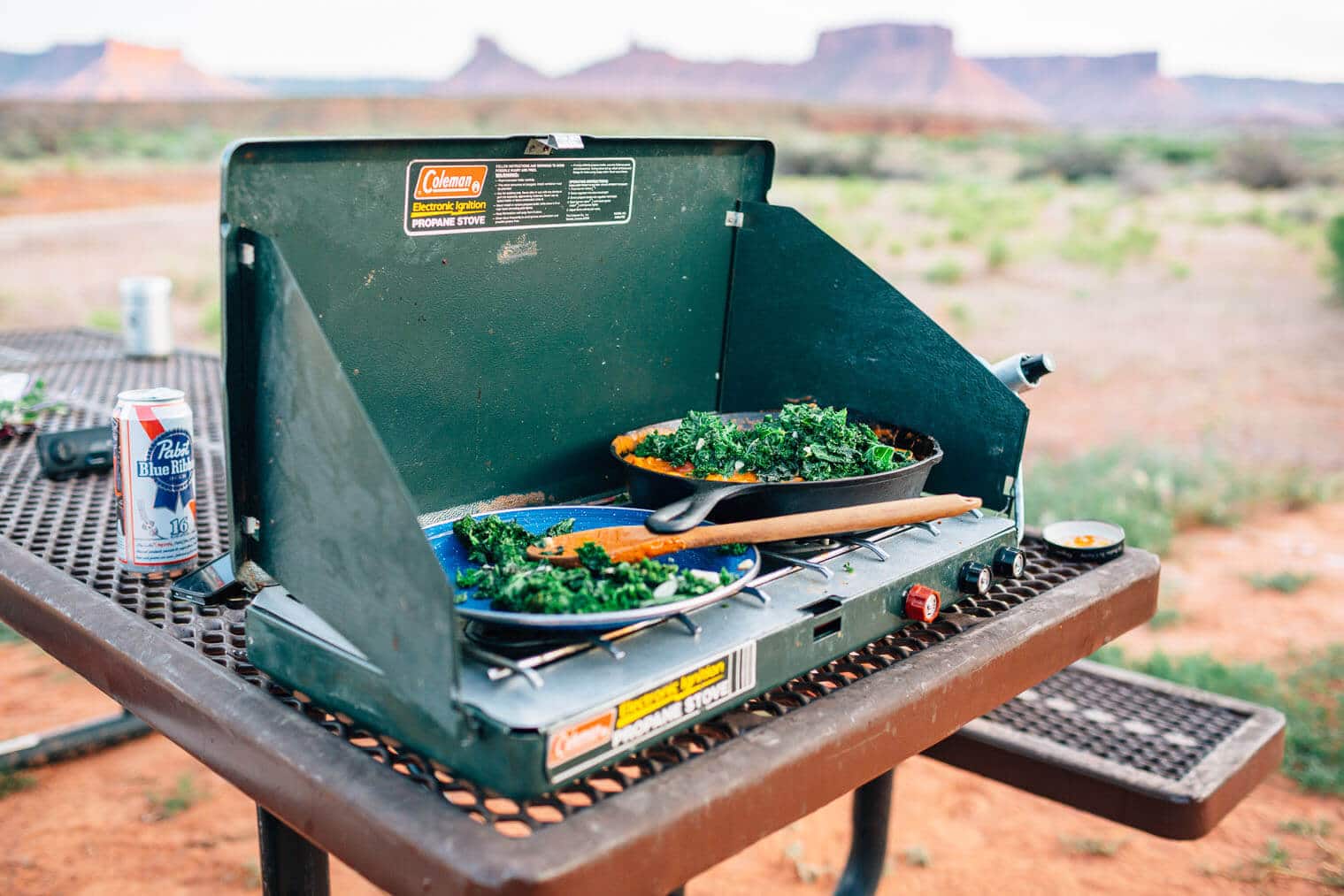
Top Recommended Camp Stoves
We cover the particular pros and cons of each camping stove later in this article, but if you want to skip straight to the conclusions here are our quick-takes for “the best camping stove in their category”.
Best All-Around 2 Burner Camp Stove: Camp Chef Everest 2X
The Everest 2X is our personal favorite and go-to stove for camping. It’s rugged, has great flame control, and features two high-powered, wind-resistant burners.
Best Budget Camping Stove: Coleman Cascade Classic
With updated controls and integrated ignition, this stove has everything you need to make basic camping meals at a very attractive price point.
Best Free Standing Camp Stove: Camp Chef Explorer 2 Burner
With two 30,000 BTU burners, the Explorer 2 Burner is a pro-level stove that’s great for cooking for larger groups.
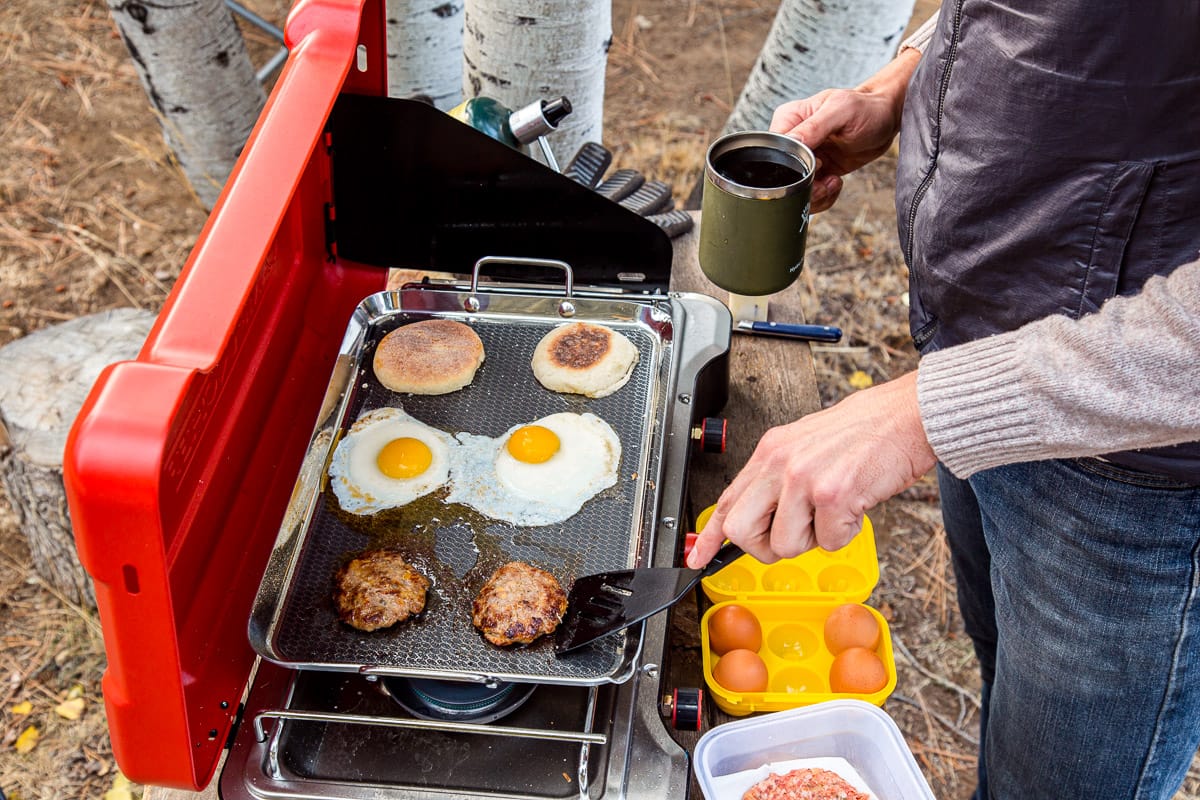
Best Camp Stoves: Reviews
Below is a list of the top camp stoves on the market. While we reviewed dozens of different stoves, we have kept the list intentionally short, highlighting just the best stove in their particular category. Hopefully this will help you cut right to the chase and find the perfect stove for your next camping trip.
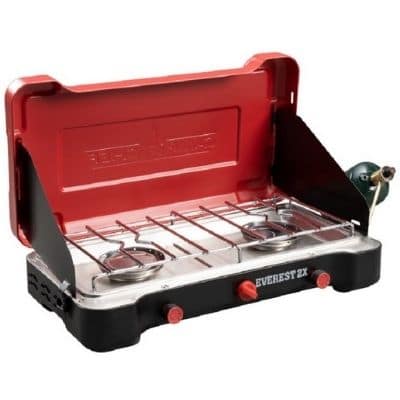
Best Overall
Camp Chef Everest 2x
MSRP: $190
Heat Output: 20,000 BTUs per burner
Fuel Type: Propane
Auto-Ignite: Yes
Pros: The Camp Chef Everest 2X is our favorite camp stove. We owned the predecessor to this stove, the now discontinued Camp Chef Summit, and we’re very impressed with improvements made for the Everest 2x.
The push-button ignition has been replaced with a more ergonomic twist ignitor, the plastic locking mechanisms have been replaced with rugged metal latches, and the short side windscreens have been replaced with much larger wedge-shaped windscreens.
But the thing we absolutely love about the Everest 2x is its two 20,000 BTU burners. This camping stove has a ton of power, allowing you to easily overcome variable outdoor conditions. The burners are also nicely recessed into the metal frame and surrounded by a protective sheath, allowing you to dial down the flame even in breezy weather.
Because of it’s excellent flame control, the Everest 2x is capable of cooking even the fussiest camp meals, letting you cook nearly anything that you would be able to cook on your stove at home. From searing steaks to simmering risotto, this stove great dynamic range.
Cons: The main drawback to the Everest 2x is its somewhat bulky size. It is slightly heavier than other briefcase style stoves, but is still very portable.
Bottom Line: The Everest 2X is the best 2-burner camping stove we tested. Durable construction, sensibly designed, and with a ton of extra power, this stove outperforms every other camp stove we’ve ever used.
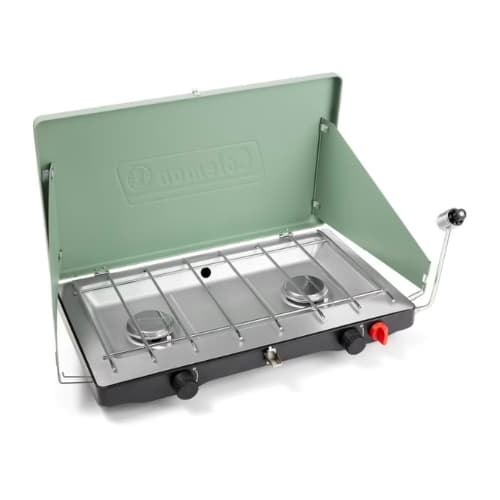
Best Budget Stove
Coleman Cascade Classic
MSRP: $100
Heat Output: 10,000 BTUs per burner
Fuel Type: Propane
Auto-Ignite: Yes
Pros: The Coleman Cascade Classic is an update to Coleman’s original classic stove–while the color might be the most obvious change, what we’re most excited about is the improvement of the flame control dials. This stove gives you a much better ability to fine-tune the flame, giving you better simmer control than with the previous model.
So, why did this stove, which is $25 more expensive than the Coleman Classic (below), earn our top budget stove spot? We think the auto-ignition and the improved flame control give this stove an overall better value, in spite of the slightly higher sticker price.
Cons: While the flame control has been improved over the earlier model, it still doesn’t match the Everest 2x, so this stove is best suited for cooking simpler meals that don’t need precision heat.
Bottom Line: This is a solid, budget-friendly portable camping stove that’s perfect for couples or small families.
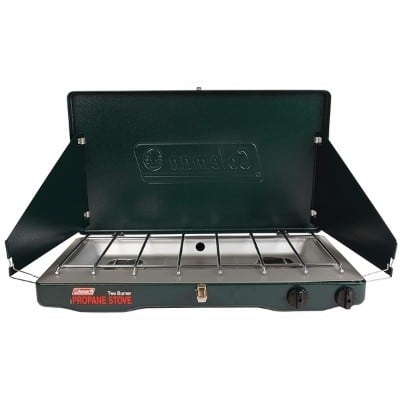
Time Tested Favorite
Coleman Classic Propane Two Burner
MSRP: $74.99
Heat Output: 10,000 BTUs per burner
Fuel Type: Propane
Auto-Ignite: No
Pros: The Coleman Classic was our first camp stove. It is a no-frills, basic tabletop stove that has proven to be very reliable for us over many years of use. What we love most about the Coleman Classic is the tremendous value it offers. It might not have all the new bells and whistles, but it’s a very serviceable 2 burner camp stove for under $100.
Cons: This stove has two major drawbacks. The first is the lack of an auto-ignition system. The second is the less-than-responsive valve, which can make dialing in the temperature difficult. This results in a flame that is more susceptible to being blown out, requiring it to be manually relit more often. It’s a vicious circle of irritation.
Additionally, as with many long-running product models, there have been allegations by users online of declining quality control and workmanship. However, personally speaking, our stove has continued to work very well over the years. And, Coleman still backs this camp stove with a 3-year warranty.
Bottom Line: If you’re shopping on a budget and looking for some simple and reliable, the Coleman Classic camping stove is an excellent choice.
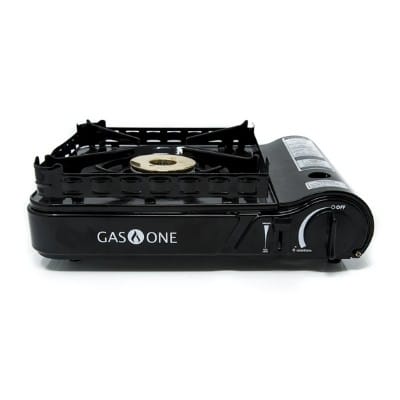
Best One Burner
Gas ONE Dual Fuel
MSRP: $59
Heat Output: 15,000 BTU (single burner)
Fuel Type: Propane / Butane
Auto-Ignite: Yes
Pros: The Gas One Dual Fuel is a single burner camp stove that runs off either propane or butane, allowing you to burn cheaper butane in the warm summer months, and then switch to high-performance propane in the cooler shoulder seasons. It features an impressive broad 15,000 BTU burner, responsive flame control valve, an auto-ignition system, and multiple layers of wind protection.
Cons: In order to get those extra features and increased performance, the Gas One does end up being slightly larger and slightly more expensive than other single burner stoves. In our opinion though, the increase in size is well worth it.
Bottom Line: The Gas One Dual Fuel is a super versatile single burner stove that pairs high-end features with a high-performance burner. Great as a primary stove for one-pot meals or as a supplemental burner.
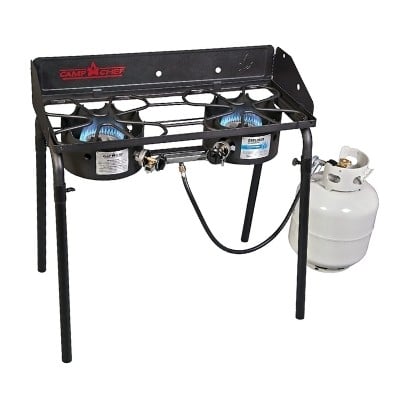
Best Freestanding Stove
Camp Chef Explorer Double Burner Stove
MSRP: $149
Heat Output: 30,000 BTU (per burner)
Fuel Type: Propane
Auto-Ignite: No
Pros: Unlike the other stoves on this list, the Camp Chef Explorer is free-standing and comes with adjustable height legs. This allows you to place it anywhere, without needing to have a camping table to set it on.
This really is a professional quality cook system, with two broad 30,000 BTU burners, responsive flame control, a generous cooking area, and substantial wind protection (individual burner ring & cook surface wind shroud).
Cons: The major downside to this stove system is its size. While the legs do collapse down, it is still a 29” by 14” package weighing in at 36 pounds, which might be too unwieldy for space-conscious campers. Another thing to consider is that the Camp Chef Explorer is designed to use a large refillable canister (sold separately). Not necessarily a con, but something to keep in mind.
Bottom Line: The Camp Chef Explorer is a professional quality stove system that is probably better than the stove in your house. If you do a lot of cooking outdoors–especially for larger groups–and have a little extra space, then this is a great option.
Comparing The Best Camping Stoves
| Stove | BTU (each burner) | Auto-Ignition | MSRP |
|---|---|---|---|
| Camp Chef Everest 2x | 20,000 | Yes | $190 |
| Coleman Cascade Classic | 10,000 | Yes | $100 |
| Coleman Classic Propane | 10,000 | No | $74.99 |
| Gas ONE Dual Fuel | 15,000 | Yes | $59 |
| Camp Chef Explorer | 30,000 | No | $149 |
Why trust us?
Our recommendations are based on extensive first hand experience, giving insights we never would have known had we just read marketing materials online. With years of outdoor cooking experience under our belts, we’ve made literally hundreds of meals on various camping stoves (check out the catalogue of camping recipes that we’ve developed!).
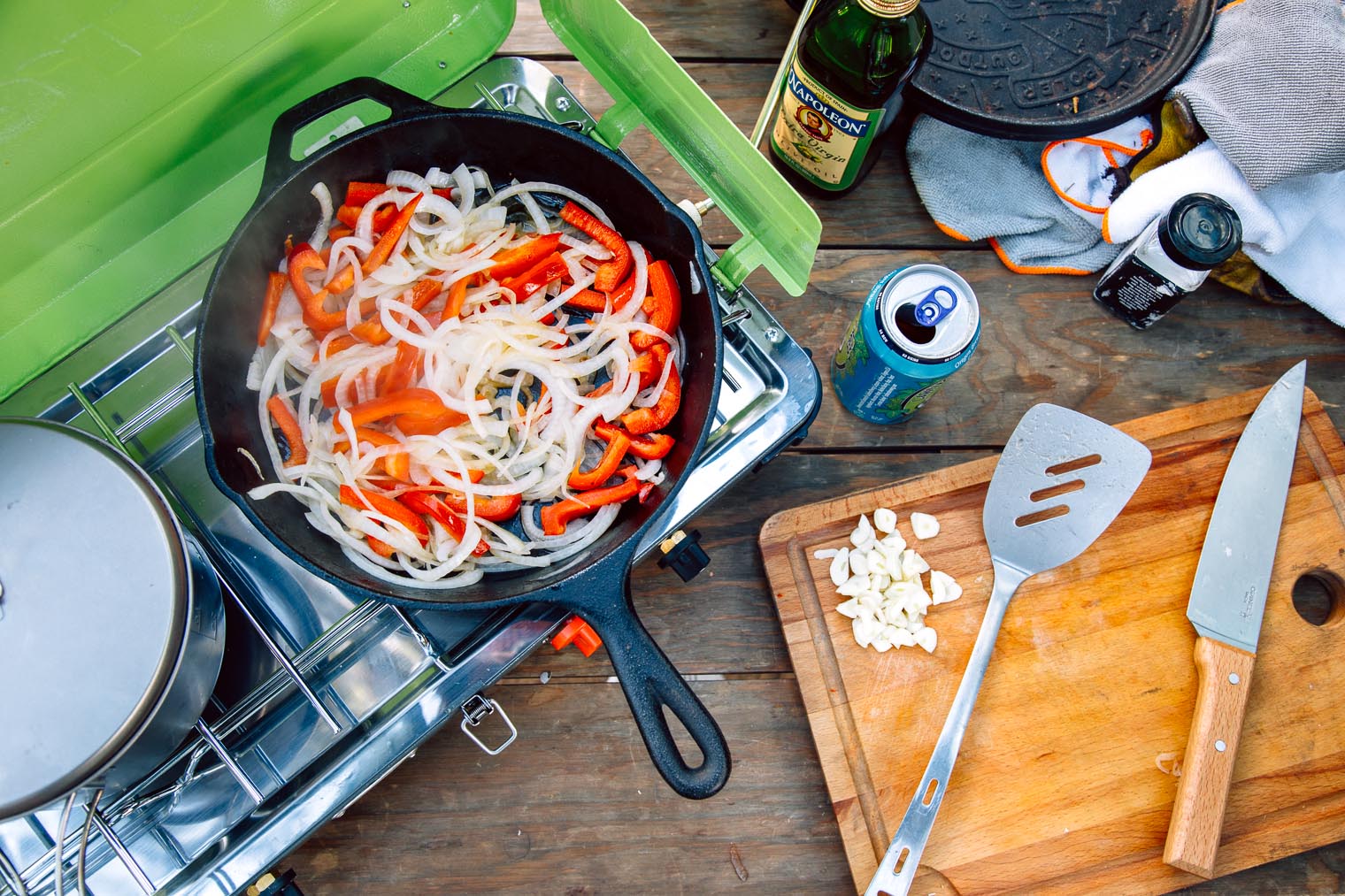
Camping Stove Features To Consider
There are a lot of factors to consider when buying a new camp stove, but don’t get overwhelmed! Just think about how you intend on using it and you will naturally take note of the factors that are important to you. Also, where we think it’s relevant, we’ll chime in to give you our two cents, too!
Number Of Burners
How many burners do you need? This will largely depend on the size of your group and your style of cooking.
- One Burner: If you’re cooking for a small number of people and enjoy making one-pot meals, you will be surprised just how much you can get done with a single burner. These types of stoves are relatively lightweight and take up the least amount of space.
- Two Burners: The most common type of camping stove is the two-burner setup—and for good reasons. This type of stove offers a lot of versatility in a relatively compact form. For us, cooking on a two-burner stove feels very similar to the way we cook at home.
- Multi-Burner: We find it very rare that we wish we had more than two burners at a campsite, however, if you’re cooking for a large group or family, it might be nice. Some stoves offer a 3 burner configuration, like the Camp Chef 3x Explorer. But we wearing of models that try to shoehorn in an extra burner into an already cramped briefcase design – there just isn’t enough room.
Our Take: For most recreational campers, a two-burner stove is the most versatile option. Being able to boil water and saute at the same time feels the most like cooking at home.
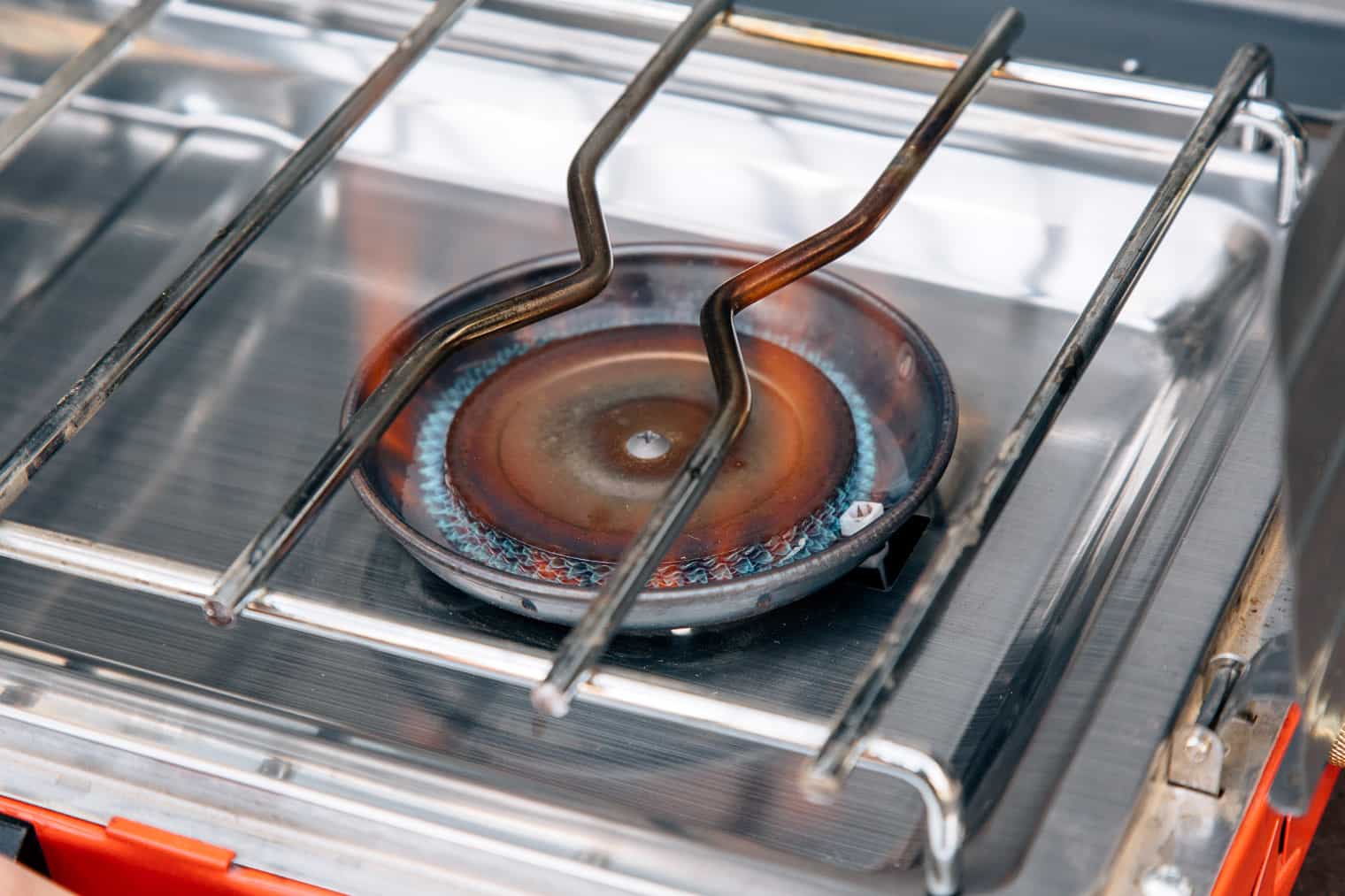
Burner Power
Burner power is measured in BTUs (British Thermal Unit). The burners on most camping stoves run between 10,000 and 20,000 BTUs. For comparison, a typical home stove burner runs between 7,000-12,000 BTUs.
Camp stoves tend to have higher burner power than home stoves because they are designed to be operated at colder-than-room-temperature conditions and need to contend with the wind. Burners with extra BTUs can really go a long way to level the playing field, allowing you to “power through” conditions.
Burner Dimension
The actual diameter of the burner is an important thing to consider, too. A small burner will produce a small hot spot right under your pan. A larger burner will spread the heat more evenly. Generally speaking, the wider the burner’s diameter, the better for even cooking.
Cooking Area
For two-burner camp stoves, the distance between the burners and the overall cooking space between the side windscreens can restrict the size of the cookware you will be able to use.
Some two-burner stoves might only be able to accommodate two 10” inch skillets at the same time while others are able to accommodate one 10” and one 12” skillet.
Our Take: Unfortunately, some stove manufacturers like to overstate what size skillets their stoves can accommodate. While it might be possible to shove two 12” skillets onto the cooking surface, if the skillets aren’t centered over the burners, there will be hot spots and uneven cooking.
Wind Resistance
As mentioned above, wind can play a major role in the overall performance of your stove. Even a gentle breeze can really throw off your cook times—especially when simmering at low heat.
Two-burner stoves usually have some degree of wind protection built into their design, some better than others. Many open like a briefcase and have folding sidewalls. Additionally, some stoves—like the Camp Chef Everest—have recessed burners that are surrounded by protective sheaths to improve their wind resistance.
Simmer Control
How low can you go? If you want to make creamy risotto, oatmeal, or polenta, you’ll need to be able to simmer on low heat. Otherwise, your food can scorch to the bottom of your pot.
Quality flame control requires very precise valves, which lower-end models frequently don’t have. Additionally, wind resistance plays a large role in a burners’ ability to hold a very low flame.
Integrated Ignition System
Many stoves come with an integrated ignition system, some easier to use than others, but all are extremely convenient…when working properly. Unfortunately, auto ignition systems are often the first thing to fail, so always be sure to have an alternate fire starter (i.e. long handle Bic fire lighter) on hand.
Our Take: This is a must-have feature for us. Having to repeatedly ignite a burner—especially when there is a hot cast iron sitting on top of it—can be difficult and annoying.
Free Standing Vs Tabletop Stoves
For campers staying at established campgrounds with picnic tables, a tabletop camping stove is great choice. They are compact, lightweight, and portable. However, if you’re doing a lot of boondocking out on public lands, and won’t have access to ample table room, then a free standing stove might be a better option.
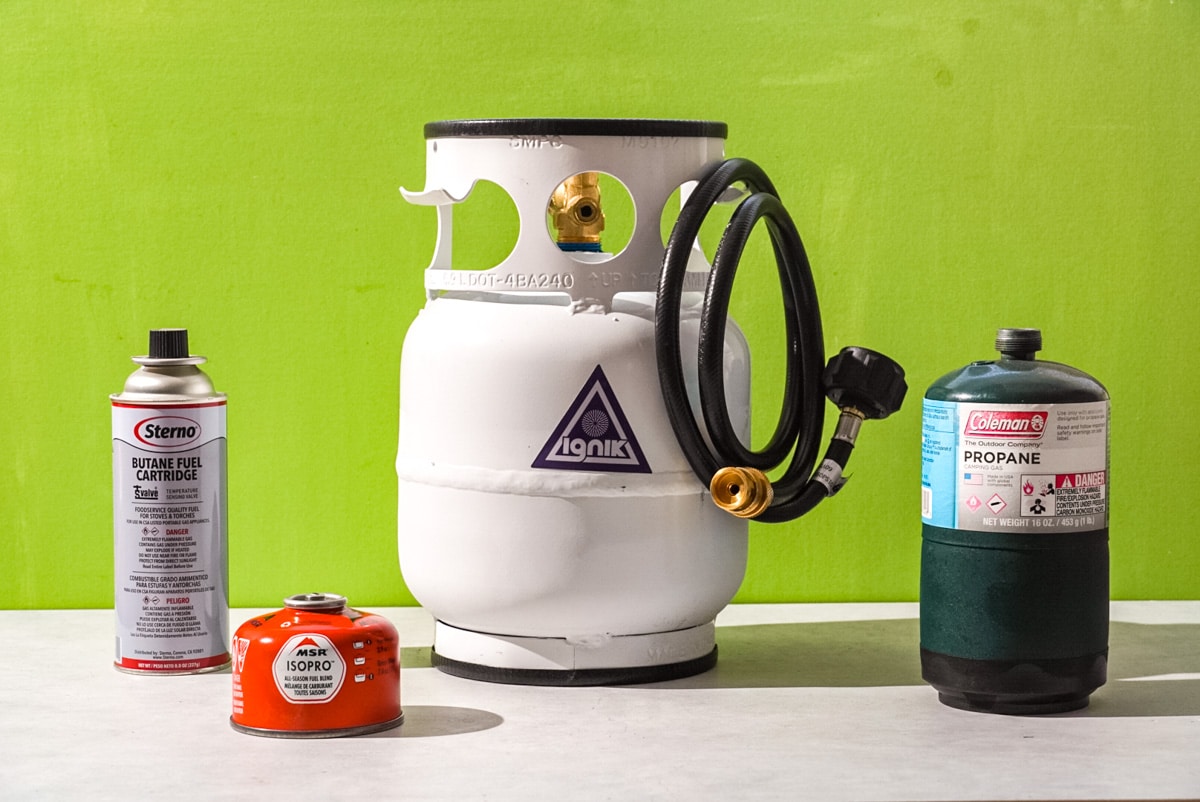
Camp Stove Fuel Types
The most commonly used fuel for camping stoves is propane. However, some camping stoves also run off of isobutane and butane. So what’s the difference?
- Propane: Propane is by far the best performing and most common type of camping stove fuel. The single-use green propane bottles can be found at virtually every gas station, grocery store, and hardware store across the country. Propane stoves can also be attached to larger reusable tanks when fitted with the proper adaptor. A reusable propane tank can save you a lot of money on fuel costs over time and can be refilled at most gas stations, reducing waste.
- Isobutane: This fuel is most commonly used by lightweight backpacking stoves. While it offers decent performance when it’s cold, its main advantage is being lightweight—which isn’t as critical a factor for car camping. Isobutane is also the most highly processed and therefore the most expensive type of gas. But, if you do a lot of backpacking and want buy just one type of fuel, it might make sense to buy a camping stove that uses isobutane.
- Butane: Butane is remarkably cheap, but it does not perform well in colder temperatures. As temperatures approach 30F, this fuel will struggle to power a stove, making it better suited for warm weather climates.
Our Take: For the vast majority of recreational campers, we would recommend a propane stove. They have the best performance, the fuel is cheap and widely available, approved under all but the most severe wildfire restrictions—and if you pick up a refillable tank, it’s the most eco-friendly.
Alternative Fuel Options
Wood-Burning Stoves: There are a few stoves on the market that run entirely off of biomass (wood, sticks, twigs, etc). This can reduce your fuel costs, so long as you are allowed to collect wood at your campsite. But because it’s a wood-powered flame, these types of stoves are often prohibited during wildfire burn bans. Additionally, most campgrounds require all fires to be contained within the designated fire ring.
Dual Fuel Camp Stoves: These old-school, manually pressurized camping stoves can run off of either white gas or unleaded gasoline. The most iconic model is the Coleman Powerhouse Dual Fuel. While these types of coleman stoves are beloved by many long-time car campers who want fuel flexibility, we feel they can be more finicky than the average camper wants to deal with.
Where To Buy Camping Stove Propane
In the United States, there are three different ways to buy propane for your camp stove.
1. Single-use 1 lb green propane bottles. Available at virtually every outdoor retailer, grocery store, and gas station across the country, these green propane canisters can be sold under various names (Coleman, Bernzomatic, Ace Hardware) but they are all made by the same company: Worthington Industries. They can not be refilled (single use only). And while they are technically recyclable, finding a municipality that will accept them is very difficult if not impossible in some areas.
2. Refillable propane tanks: Refillable propane tanks are manufactured in a variety of sizes and can be purchased at many hardware stores and home improvement centers. Typical sizes for consumers are 5 lbs, 10 lbs, and 20 lbs. Many gas stations, U-Haul locations, hardware stores sell propane in bulk. You will need to see an attendant to have it refilled, but this is by far the most economical (and least wasteful) way of purchasing propane.
3. Swap stations (20 lb tanks only): Operated by Blue Rhino and Ameri-Gas, these swap stations can be found at many gas stations, grocery stores, and hardware stores. Just leave your empty tank by the locker outside, see a store attendant, pay the exchange price, and they’ll give you a new pre-filled tank. You can also buy a pre-filled tank without an exchange (for a higher price). Returned tanks are inspected and leak-tested.
While this option offers some level of convenience, you will be wildly overcharged compared to buying propane in bulk. In our experience, it’s roughly a 30% upcharge per swap compared to just getting it refilled.
Our Take: We have used the green 1 lb canisters for years. Particularly for occasional campers, they are just very convenient. However, we have upgraded to an Ignik refillable propane tank and would recommend the switch if you are a frequent camper and your stove will accommodate an adapter.
Propane Stove Accessories
Propane Hose Adaptors: Gas One makes propane hose adaptors in a variety of sizes including 4’ and 8’ that is designed to work with most camp stoves
Ignik 5lb Propane “Growler”: This kit includes a 5 lb refillable propane tank, a 4’ adaptor hose, and a stylish carrying case. It’s more expensive than just buying a generic tank and adapter, but we have to award it some style points.
Propane Tanks: Available for purchase at most hardware stores and home centers, we would recommend either a 5 lb or 10 lb refillable tank. These are big enough to last for a several days of camping but small enough to transport.
Camp Stove Accessories
We could probably devote an entire article to camp cookware, but there are a few camp stove-specific accessories that are good to keep in mind.
Counter-Height Work Surface
Most campground picnic tables are at table height (28 inches), which results in an awkward, semi-hunched cooking stance. Additionally, the fixed benches get in the way on the sides, and the ends of the table have limited space. So why don’t we just go home!
Thankfully there are a variety of foldable counter-height (32-36 inches) camp cook stations, some with more features than others, that can really improve your outdoor cooking experience.
- GCI Outdoor Slim: The GCI Outdoor Slim-Fold Table is a collapsible workstation that offers plenty of room to spread out. If you’re looking for a simple camp kitchen, this is a great budget-friendly option.
- SylvanSport Outdoor Camp Kitchen: If you do a lot of camping and want to invest in a “designer camp kitchen” then look no further than the SylvanSport Outdoor Camp Kitchen. Intuitive collapsible design, beautiful bamboo countertops, tons of storage shelves, windscreen, and an integrated sink basin.
Omnia Stove Top Oven
The Omnia Stove Top Oven is one of the biggest upgrades you can make to any camp stove. Enjoy freshly baked cinnamon rolls, nachos, or a breakfast frittata using your standard camp stove. Check out this article to learn more about how to use the Omnia Oven.
Long Handled Lighter (backup)
If your camp stove doesn’t come with an auto-ignition switch, a long-handled lighter is the best option for lighting your burners. Avoid using short Bic lighters or matches. And even if your stove does have an auto-ignition system, we would still highly recommend having one of these as a backup!
Wooden Shims
If your stove doesn’t have adjustable foot pads for leveling, we would highly recommend bringing along a couple of wooden shims. Sure, you can hunt around for a perfectly sized rock or stick to wedge under there, but these wooden shims are foolproof, adjustable, and dirt cheap.
Steel Wool
Grease spray, pasta water, and food scraps, it’s inevitable that your camp stove is going to get dirty. The best cleaning method we’ve found for the bottom tray and grate is to gently scrub with steel wool. It might take a little bit of effort, but you can get that stainless steel back to sparkling new in no time. However, you will want to avoid using steel wool on painted parts of the stove.
For more tips on how to clean your camp stove, check out this article by Van Camping Life.
Hungry for more?
Once you’ve added a great stove to your camp kitchen, the sky is really the limit! Explore all the camping recipes on Fresh Off The Grid, or dive into these great camping breakfasts, easy camping meals, Dutch oven recipes, and tasty camping desserts.


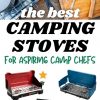
Don’t overlook the Tembo Tusk Skottle. It’s a griddle-style that is extremely versatile and capable of some amazing dishes!
Thanks for the recommendation! We’ve seen it around online but never had the chance to see it in use. Looks like it would be great for large groups.
We have a COBB PREMIER ‘KITCHEN IN A BOX’ which is charcoal driven. It uses only 6-14 briquettes at at time – very economical and compact. Anything you can prepare in your oven or on your stove at home, can be prepared on a COBB – roasting, boiling, frying, smoking, grilling and even baking! Eat real food. Eat well wherever you go! ????????
One option you didn’t mention is the classic “Coleman 425” stove, which runs off “white gas” (camping fuel) or gasoline. I’ve never used gasoline in mine, but I’ve burned gallons of camping fuel over the years. Coleman has made them forever (my grandfather had one, and my father still has his…they last nearly forever), and you don’t generate empty green propane canisters (which can be recycled, but which I see in campground dumpsters frequently). They also have the advantage of using gasoline in a pinch – I’m no “prepper”, but I have been without power for several days and the option is nice to have.
Thank you for the article – I did not know about the butane low-temperature problem, and learned something new.
I have the same camp stove and personally I love using it to its fullest potential! It’s a briefcase dual burner stove! So I store cookware and other small items in it when it’s cool, and get them out once camp is set up!
Also technically it is a a tri-fuel stove.
I purchased an adapter on Amazon for ‘AI think’ $15,and it allows me to use the small REFILLABLE 1lb propane cylinders ‘check for leaks by dunking under clean water and checking for bubbles after refill’ or a hose and 20+lb propane tank.
So having the choice of 3 fuels is wonderful! Use what you have on hand practically!
Partner steel all the way, surprised no mention of them
We have seen them around and a lot of people have great things to say about them. But we haven’t used it personally yet.
I have had two coleman two burner stoves fail @ inopportune times. First was the fuel connection piece stripped. The second was the locking nut on the
stove was loose so the fuel connector would not allow it to be tight enough. This led to a fuel line failure. Thanks for the list, I will have to consider one of these options
I highly recommend this little grill, it’s great for one or two
https://www.amazon.com/Iwatani-Fired-Burning-ABURIYA-CB-ABR-1/dp/B01IGHIFV4/ref=pd_lpo_vtph_86_tr_t_1?_encoding=UTF8&psc=1&refRID=3TB0PDBNNRBDV29XV3QB
Interesting. We will have to check that one out. Do you use it primarily for grilling? Or with cookware like skillets as well?
We picked up a Stainless Steel Petromax Atago last year! Best investment we have ever made. Awesome charcoal grill for grilling, take the grill off and drop in any cast iron pot under 6 quarts. We also have the Petromax fire griddle that sits on top of the Atago (think Skottle) and a fireproof dome that turns the Atago into an oven. Then after supper, we put the percolator in for a nice coffee. Add some wood and the embers from the coals start the wood fire for the rest of the night. Travels in a round bag 15″ in diameter X 7″ high when the legs are folded down.
Thank you for posting this! I’ve been waiting to make a decision and I think I am going to go with this model.
Thanks for sharing this very informative article. Does Kovea brand have camping stove? saw this kovea heater you guys might wanna check on this too https://shop.campinggears.ph/search?q=kovea+heater
We have seen a few Kovea stoves around, and some of them look quite nice. However, they seem to do a lot of isobutane powered stoves. While we like using isobutane for backpacking because it’s lighter, we would recommend propane for car camping stove. Propane is cheaper, more widely available, and has better performance at a wider range of temperatures.